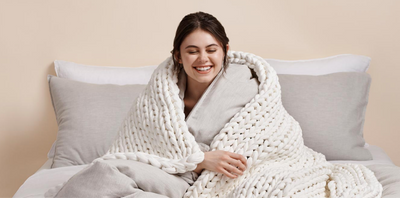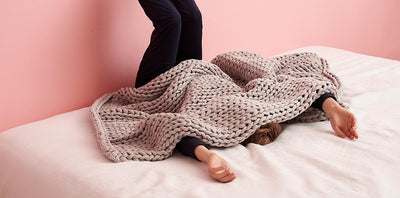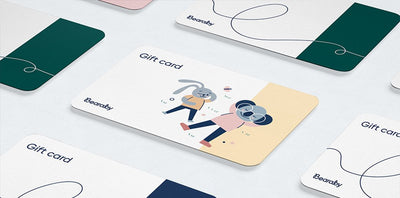What Is Brown Noise? The Science Behind the Sound
From white noise to pink noise to brown noise, there are plenty of soundscapes to choose from when it comes to sleeping and studying. Brown noise in particular has become increasingly popular as a soothing, low-frequency background noise. Read on to learn more about this trending sleep sound and how you can use it in your daily routine.

Bearassentials
Brown noise, or “Brownian noise”, emphasizes sounds on the lower end of the frequency spectrum and sounds a little like heavy rainfall
Many people use brown noise as a sleep aid
Brown noise can also be used to help with concentration while working or studying
Did you know?
White noise, brown noise, and pink noise are all different kinds of signal noise which originate from disturbances in electrical signals.
If you’re somebody who needs peace and quiet to fall asleep, you might have heard that it’s a good idea to listen to brown noise at night through a noise machine or your phone. But how can more noise help you fall asleep? And what is brown noise good for?
Brown noise — a low, rumbling sound — can help people sleep by blocking out other, more disruptive background sounds. It can also be used to create a more productive working or studying environment. Some people with ADHD even find that it helps them manage their symptoms.
What Is Brown Noise?
Brown noise is not actually named after the color brown — it’s named after “Brownian motion”, which is a scientific term that describes the way the different sounds within the noise are spread out across the frequency spectrum.
So what frequency is brown noise? Unlike white noise or pink noise, brown noise ends up concentrated in the lower frequency spectrums. That means the overall sound of brown noise is lower, which is easier on the ears of many listeners — especially since our ears naturally perceive higher noises as being “louder.”
What is the difference between pink and brown noise?
When it comes to the listening experience, pink noise is basically brown noise with a little more static. It’s often compared to the sound of a flowing water or rustling wind, or described as simply “ambient noise.”
To better understand the difference between pink noise and brown noise, it’s best to consider them in comparison to white noise.
White noise contains an equal amount of noise from all parts of the frequency spectrum. That means that when you listen to white noise, you’re hearing a range from the lowest, rumbliest sounds to the highest, tinniest sounds.
Pink noise contains all of these sounds, too, but in different amounts. In pink noise, the lower sounds on the frequency spectrum are more intense than the higher sounds.
This is why listening to pink noise can feel more like listening to ambient background noise or gentle flowing water.
Brown noise, on the other hand, is like a more extreme version of pink noise where the low frequencies are much more pronounced, and the higher frequencies are much softer.
As a result, brown noise is often compared to the sound of heavy rain or a rushing waterfall. When it comes to the listening experience, a good example of what brown noise is would be the experience of listening to a thunderstorm, but with fewer unpredictable sounds.

Brown Noise and Sleep
Now that you know what brown noise is, you might be wondering: what is brown noise used for?
Many people use brown noise for a better night’s sleep or to concentrate while working. It’s often recommended alongside other sleep aids like knitted weighted blankets for folks who find themselves tossing and turning at night
What is brown noise for sleep, though? And why does listening to noise help people relax?
It might have more to do with the soundscape that’s already around you than the noise itself. Ordinary background sounds (think traffic, or your night-owl upstairs neighbor) can be startling or irritating when you’re trying to sleep. A constant, steady noise like brown noise can drown out these irregular background sounds, creating a more restful soundscape.
That said, according to the Sleep Foundation, more research still needs to be done to find out whether it’s all about soundscapes, or if there’s some inherent property of the white, pink, or brown noise that makes it so relaxing.
It’s also not totally clear whether listening to noise is a healthy sleep aid for everyone — white noise, for example, actually makes it harder for some people to drift off.
So if you’re wondering whether you should sleep with brown noise in the background, it’s really all down to your own personal preference. It may or may not help you fall asleep, but if you find listening to the noise relaxing, it can be an easy way to unwind at the end of the day.
For many people, the best way to use brown noise for sleep is to pair it with other sleep hygiene adjustments like reducing blue light (that means phone usage!) before bed.
And if you’re looking for a snuggle upgrade that helps you stay asleep through the night, our hand-knitted weighted blankets might be a useful option.
Cotton Napper

Dreamy, buttery softness
Calms body & mind for deeper sleep
Hand-knitted huggable comfort
It's Napper Time
What Does Brown Noise Do?
Anecdotally, we know that brown noise helps people to fall (and stay) asleep, and that it can help people concentrate while studying or working. But scientifically, brown noise hasn’t yet been proven to help with sleep or concentration.
So why is brown noise so popular? It’s simple — people like to listen to it!
While white noise and pink noise both boast the same distraction-reducing properties, there’s something about the low, resonant sonic quality of brown noise that makes it feel comfy and easy-on-the-ears.
Brown noise benefits can include better sleep, relaxation, and focus, but it’s the fact that people enjoy listening to brown noise that has helped it gain so much popularity.

What does brown noise do for ADHD?
Some people with attention-deficit issues find that brown noise helps to occupy part of their brain, reducing distractions and allowing them to focus on the task at hand.
Although the connection hasn’t been thoroughly studied, scientists are also beginning to find a relationship between noise and ADHD symptoms.
A 2019 study found that white noise has therapeutic potential for patients with ADHD. Another study in 2020 concluded that different “colors” of noise could help create more productive work environments.
Brown noise TikToks about using brown noise for ADHD have also started gaining popularity in recent years. Many creators share their own personal experiences with brown noise and ADHD, spreading the word about this calming, lower frequency alternative to white noise.
So while it isn’t yet prescribed as a medical treatment, brown noise can fit in well with other tools for managing ADHD symptoms such as sensory toys or stress relief pillows.
Brown Noise Risks
Brown noise shouldn’t be harmful for your health, but as with any sound, you should keep one key safety tip in mind: don’t turn the volume up too loud!
If you enjoy the sound of brown noise, it might be tempting to keep increasing the volume in order to tune out other noises. But just like when you’re listening to music, it’s important to stick to safe volume levels, keeping noise below 70dBA.
Conclusion
Brown noise (or Brownian noise) belongs to the same family as white noise and pink noise. Unlike white noise, brown noise is concentrated on the low end of the frequency spectrum.
Our ears are tuned to pay attention to higher frequency sounds like the human voice. This may help explain why lower pitched sounds can be more soothing and relaxing to listen to, and what is the difference between brown noise and white noise: white noise contains equal amounts of sound from the full frequency spectrum, so it contains some unpleasant higher-pitched sounds that are less audible in lower-pitched brown noise.
Whether you prefer listening to brown noise, white noise, or pink noise, taking control of your soundscape while you sleep or work can be a great way to help yourself relax and feel grounded.







